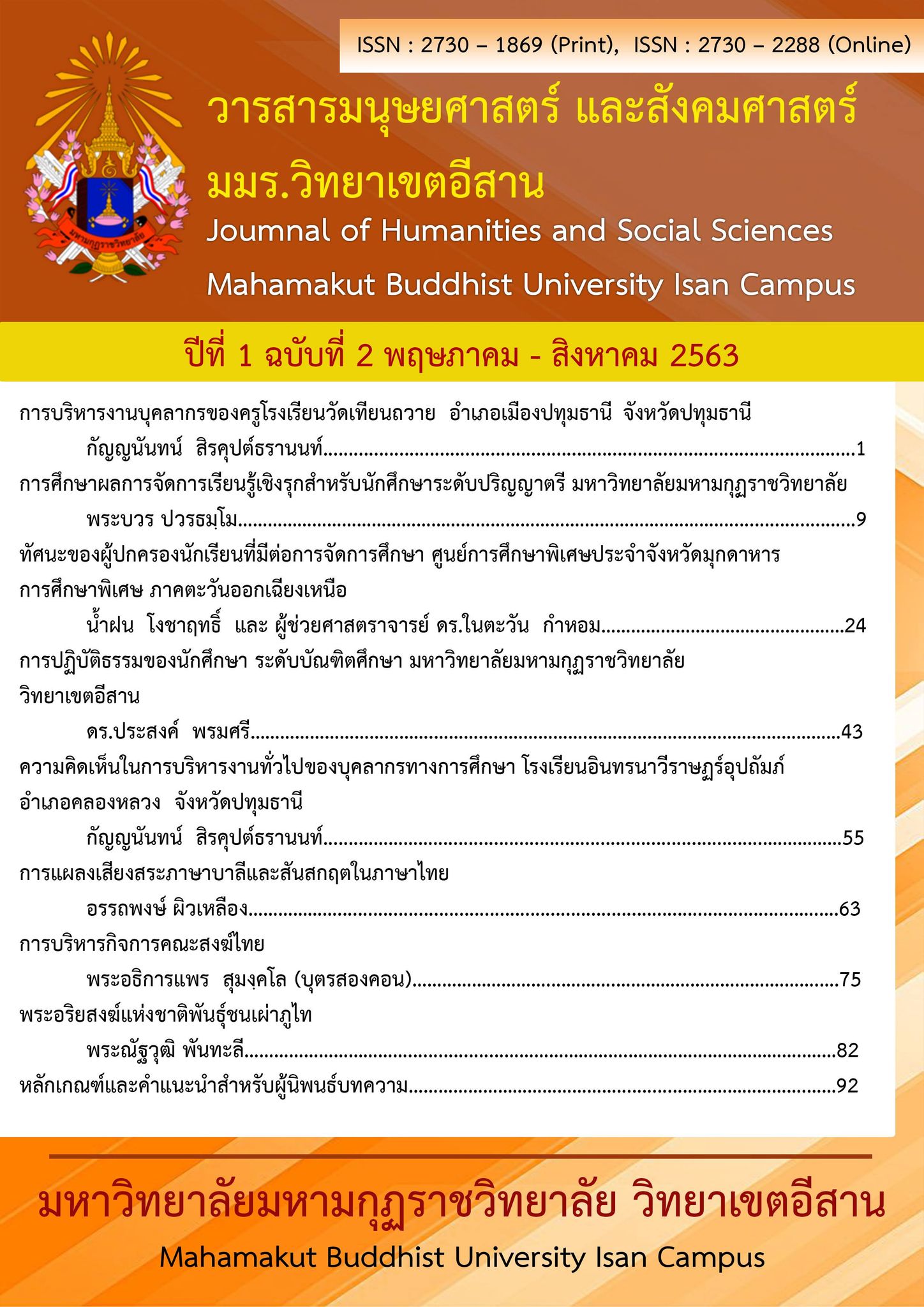การปฏิบัติธรรมของนักศึกษา ระดับบัณฑิตศึกษา มหาวิทยาลัยมหามกุฏราชวิทยาลัย วิทยาเขตอีสาน
คำสำคัญ:
ปฏิบัติธรรม, อารมณ์บทคัดย่อ
การวิจัยเรื่องนี้ มีวัตถุประสงค์ 3 ประการ คือ 1. เพื่อศึกษาการปฏิบัติธรรมตามหลักพระพุทธศาสนา 2. เพื่อศึกษาการปฏิบัติธรรมของนักศึกษาระดับบัณฑิตศึกษา มหาวิทยาลัยมหามกุฏราชวิทยาลัย วิทยาเขตอีสาน และ 3. เพื่อสังเคราะห์แนวทางส่งเสริมการปฏิบัติธรรมเพื่อพัฒนาอารมณ์ของนักศึกษาระดับบัณฑิตศึกษา มหาวิทยาลัยมหามกุฏราชวิทยาลัย วิทยาเขตอีสาน
ผลการวิจัยพบว่า : การปฏิบัติธรรมตามหลักพระพุทธศาสนา ได้แก่ 1. การละเว้นความชั่ว การทำความดี และการทำจิตให้บริสุทธิ์ 2. การให้ทาน รักษาศีล และการภาวนา 3. การปฏิบัติสมถและวิปัสสนาภาวนา ส่วนการปฏิบัติธรรมของนักศึกษาระดับบัณฑิตศึกษา มหาวิทยาลัยมหามกุฏราชวิทยาลัย วิทยาเขตอีสาน ได้แก่ การให้ทาน คือ การถวายน้ำปานะ การถวายภัตตาหาร การรักษาศีล คือ รู้จักการสำรวมกาย วาจา ทำความสะอาดที่พักอาศัย การภาวนา คือ รู้จักคิดพิจารณาหาเหตุผล อ่านหนังสือธรรมะ ฟังธรรม และมีความอดทน แนวทางส่งเสริมการปฏิบัติธรรมเพื่อแก้ไขอารมณ์ คือ 1) ด้านความคิด คือ คิดบวกและศึกษาธรรมะให้มาก 2) กัลยาณมิตร คือ พูดคุยให้เพื่อนสนิทฟังในเรื่องที่อารมณ์ไม่ดีมีมนุษยสัมพันธ์ 3) สร้างอารมณ์ดีให้เกิดขึ้น เช่น ฟังดนตรีธรรมชาติบำบัดอยู่คนเดียว เดินเล่นไปตามป่าไม้คนเดียว 4) ยึดธรรมะในการดำเนินชีวิต คือ รู้จักให้อภัย หางานที่ชอบ ปล่อยวาง และปฏิบัติสมถะและวิปัสสนากรรมฐาน แนวทางส่งเสริมการปฏิบัติธรรมเพื่อการพัฒนาอารมณ์ คือ มีระเบียบวินัย ปรับทัศนคติไปในแง่บวก ฝึกสติ สมาธิ เป็นประจำ และ บำเพ็ญประโยชน์เพื่อผู้อื่น
การสังเคราะห์แนวทางส่งเสริมการปฏิบัติธรรม จำนวน 4 แนวทาง ได้แก่ 1. การมีสติอยู่ในชีวิตประจำวัน คือ การหลบเลี่ยงอารมณ์ การข่มใจจากอารมณ์ การชนะใจตนเอง การรู้จักคิด 2. การปฏิบัติกรรมฐาน คือการปฏิบัติสมถและกัมมัฏฐาน 3. การมีกัลยาณมิตร คือ การสนทนาธรรม การศึกษาธรรมะ 4. การทำกิจกรรม คือ การบริจาคทาน การออกค่ายปฏิบัติธรรมและการทัศนศึกษาวัด
เอกสารอ้างอิง
พระพรหมคุณาภรณ์ (ป.อ. ปยุตฺโต). (2551). พจนานุกรมพุทธศาสตร์ฉบับประมวลธรรม. พิมพ์ครั้งที่ 17. กรุงเทพมหานคร : มหาจุฬาลงกรณราชวิทยาลัย.
พระพุทธโฆสเถระ. (2551). คัมภีร์วิสุทธิมรรค. กรุงเทพมหานคร : ธนาเพรส.
พระทรัพย์ชู มหาวีโร (บุญพิฬา). (2553). “การศึกษาวิธีการเจริญสติในชีวิตประจำวันตามแนวทางของติช นัท ฮันห์”. หลักสูตรพุทธศาสตรมหาบัณฑิต. สาขาวิชาพระพุทธศาสนา. บัณฑิตวิทยาลัย. มหาวิทยาลัยมหาจุฬาลงกรณราชวิทยาลัย.
แม่ชีสุดา โรจนอุทัย. (2553). “ศึกษาวิเคราะห์ปัจจุบันขณะในพระพุทธศาสนาเถรวาท”. หลักสูตรพุทธศาสตรมหาบัณฑิต. สาขาวิชาพระพุทธศาสนา. บัณฑิตวิทยาลัย. มหาวิทยาลัยมหาจุฬาลงกรณราชวิทยาลัย.
สุธรรมมา วรนาวิน. (2551). “ผลของการปฏิบัติสมาธิที่มีต่อความฉลาดทางอารมณ์ : กรณีศึกษาผู้ปฏิบัติธรรมโครงการเฉลิมพระเกียรติตามรอยเบื้องพระ ยุคลบาทวัดโสมนัสวิหาร”. หลักสูตรพุทธศาสตรมหาบัณฑิต. สาขาวิชาพระพุทธศาสนา. บัณฑิตวิทยาลัย. มหาวิทยาลัยมหาจุฬาลงกรณราชวิทยาลัย.
พระมหาเจษฎา โชติวํโส (จุลพันธ์), (2557). “ศึกษาเปรียบเทียบวิธีการเจริญสติของหลวงพ่อเทียน จิตฺตสุโภ และท่านติช นัท ฮันห์”. หลักสูตรพุทธศาสตรมหาบัณฑิต. สาขาวิชาศาสนาเปรียบเทียบ. บัณฑิตวิทยาลัย. มหาวิทยาลัยมหาจุฬาลงกรณราชวิทยาลัย.
ฐิติรัตน์ รักษ์ใจตรง. (2549). “ศึกษาการใช้อานาปานสติภาวนาเพื่อพัฒนาคุณภาพชีวิตของเสถียรธรรมสถาน”. หลักสูตรพุทธศาสตรมหาบัณฑิต. สาขาวิชาพระพุทธศาสนา. บัณฑิตวิทยาลัย. มหาวิทยาลัยมหาจุฬาลงกรณราชวิทยาลัย.
ประทีป พืชทองหลาง. (2555). “รูปแบบการปรึกษาเชิงพุทธตามหลักกัลยาณมิตร”. หลักสูตรพุทธศาสตรดุษฎีบัญฑิต. สาขาวิชาพระพุทธศาสนา. บัณฑิตวิทยาลัย. มหาวิทยาลัยมหาจุฬาลงกรณราชวิทยาลัย.



